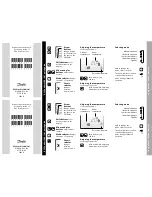
5
The basic logic on which a High or Low Level Alarm is determined, is set out in the Table below:
If there is a Low Level Alarm, then both Pumps will be locked out until the alarm is manually reset. This lockout will only be
over ridden upon a High Level condition where both the Pump Start and High level inputs are closed.
Note that after a High level is triggered, the pumps will both run until the Pump Start and Stop inputs are opened.
Mode C: Standard Configuration plus Prime Loss
As per Mode A, except Input 1 is connected to a prime loss/flow switch. If at any stage, after Pump Start, or whilst a pump
is running, the Prime Loss input opens, for a continuous 1 minute period, a fault is immediately triggered for that pump
and duty alternates. Input functions are as follows:
Mode D: Pressure Pumping Configuration
Duty Pump:
Lead Pump
Standby Pump:
Lag Pump
Input functions are as follows:
Typical Operation for Mode D:
•
Pressure drops to 400kPa: Lead (for this cycle) Pump cuts in.
•
Pressure increases and Pump cuts out.
•
Cycle continues with duty (Lead and Lag) alternating between the two pumps.
•
If pressure drops to 350kPa, Lead Pumps will cut in and remain running until Lead Pressure Switch opens circuit.
Then duty alternates.
•
No faults are logged against the Lead Pump if the Lag Pump starts.
•
The controller has inbuilt timers for “Delayed” Start and Stop to obviate pump chatter. Upon Input 1 contact closure,
the pump will not start (delay start) for 1 second and will not stop (minimum run time) for 10 seconds (or 11 sec-
onds from close of Input contacts). This “run on” occurs even if Lead Pressure switch opens circuit during this initial
period. If however run time exceeds 11 seconds, the pump will stop immediately upon “Open Circuit” occurring.
•
If the Lead Pressure Switch input closes circuit as well as he Low Pressure Switch input, both pumps will be turned
on and the Low Pressure Timer will begin counting. If this condition exists for a period of 60 seconds, then both
pumps are shut down and the system signals a level alarm. This would be typical of a Loss of Prime, or Burst main
situation.
•
Pressure switches are normally Closed and Opened on High Pressure.
Input 2
Pump Stop
Open/Closed
Open/Closed
Open/Closed
Open/Closed
Open/Closed
Open/Closed
Open/Closed
Open/Closed
Input 1
Low Level
Closed
Closed
Closed
Closed
Open
Open
Open
Open
Input 3
Pump Start
Open
Closed
Closed
Open
Open
Closed
Open
Closed
Input 4
High Level
Open
Open
Closed
Closed
Open
Open
Closed
Closed
Pump
State
Off
On
Both On
Both On
Off
Off
Off
Both On
Alarm
-
-
High Level (after Timeout)
High Level (after Timeout)
-
Low Level
Low Level
High Level (after Timeout)
Input Function
Input 1 Prime Loss
Input 2 Pump Stop
Input 3 Pump Start
Input 4 High Level
Input Function
Input 1 Not Used
Input 2 Lead Pump Pressure Switch (set at say 350kPa)
Input 3 Lag Pump Pressure Switch (set at say 350kPa)
Input 4 Low Pressure Switch (set at say 200kPa)


























